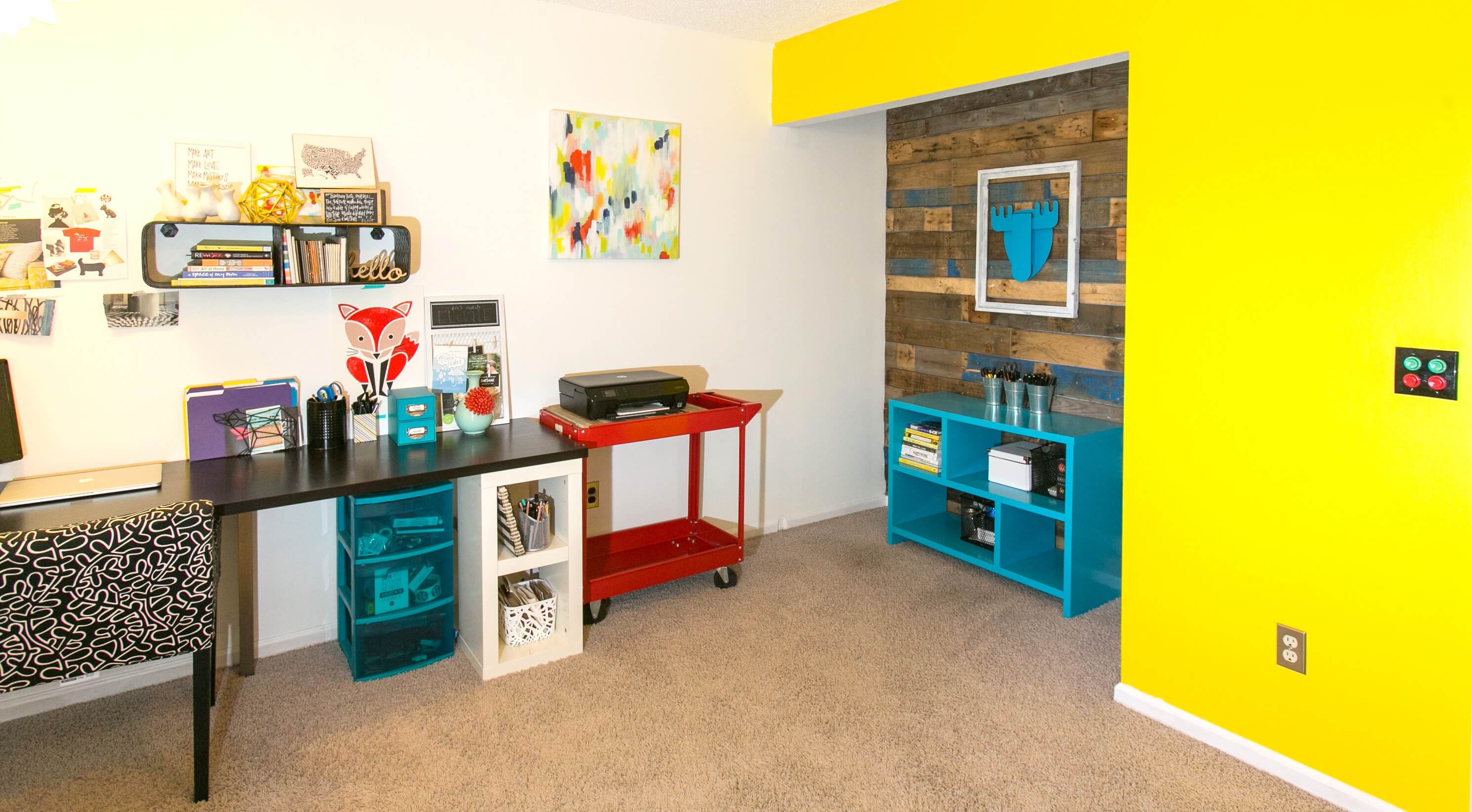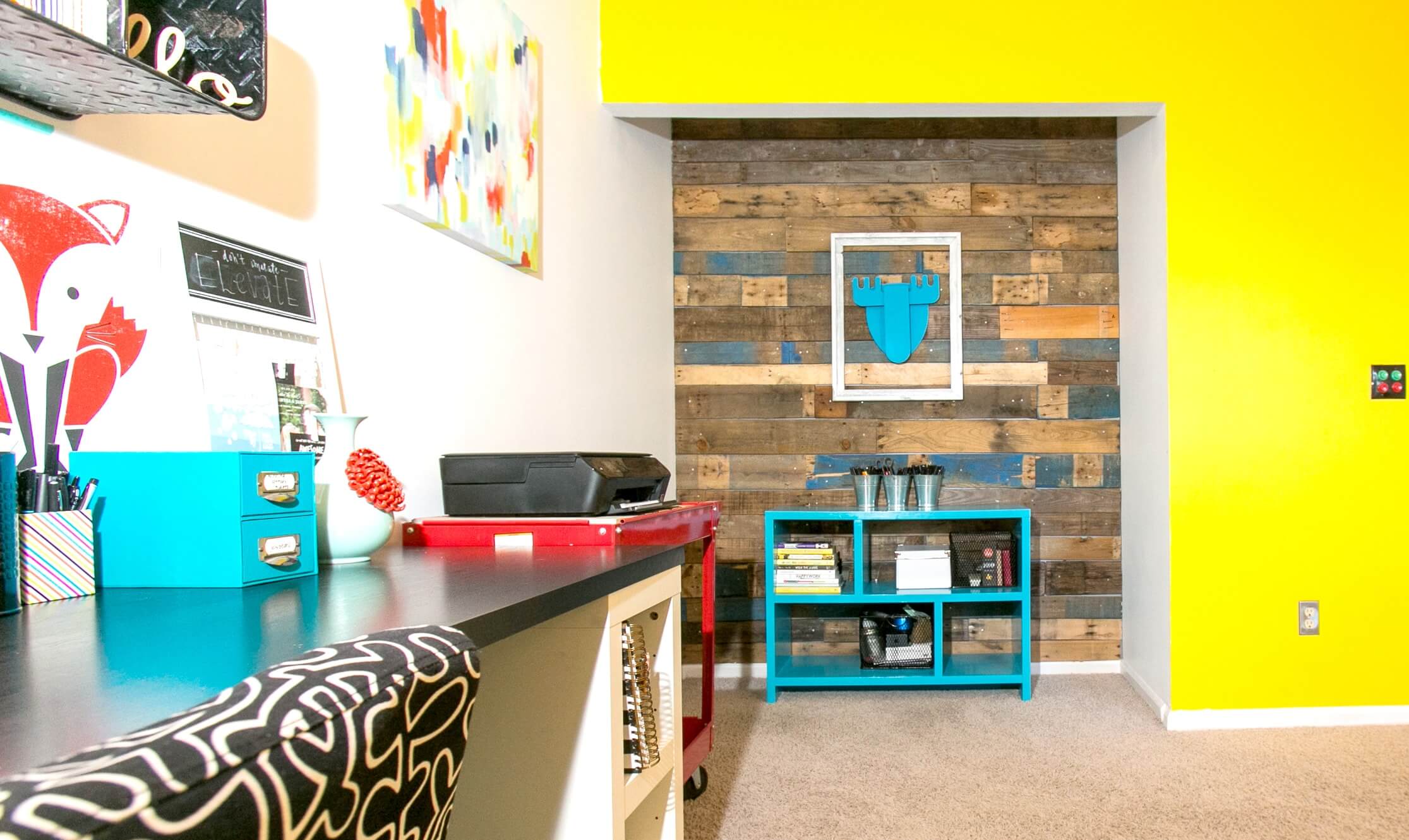Get monthly coaching and support to FINALLY gain momentum in your business without burning out in the process. 🦄 Learn more about WAIM Unlimited.




There are times when you feel like you just can’t get any work done. Your thinking isn’t clear. You have too many things racing around in your mind and instead of buckling down and getting to it, procrastination is at an all-time high.
You fall into Workload Paralysis: You stress about all the work that needs to be done to the point of needing an escape, only to come back and see even more work to be done. And on and on and on…
It’s a dark place to be in, but there is a solution. It might seem counterintuitive, but I strongly believe that setting limitations and constraints can help you get through procrastination and help you get more done.
We’ve all been there before. We feel the squeeze of a deadline and somehow manage to hunker down and get the work done just in time. Often times during the ‘squeeze’ we feel like we get in the ‘zone’.
You know the zone right? That place where you just seem to be firing on all cylinders and to-dos get knocked off like falling dominos.
One of the best ways I’ve found to master my work output is to be very strict with my calendar. For example, while writing this article I blocked off 1.5 hours. During that time my email was closed, Google Chrome was minimized, my phone was out of sight. I put on some music that helps me focus while writing (Odesza and Pretty Lights). Then I just write. Free from distractions and any potential procrastination. Of course I have moments where I can’t think of what to write next or I can feel the pull of social media. But I remind myself of the limitation I’ve set and stay focused.
My weekly calendar is filled with similar events.
There aren’t a lot of free hours in my day. 90% of the events, however, have nothing to do with phone calls or meetings. Heck, I used to even set times on my calendar to check email and social media (thanks 4-Hour Workweek).
I block off time on my calendar for writing, for strategy sessions, for customer support stuff, for life tasks (appointments, errands, etc), and I even block off time to NOT work.
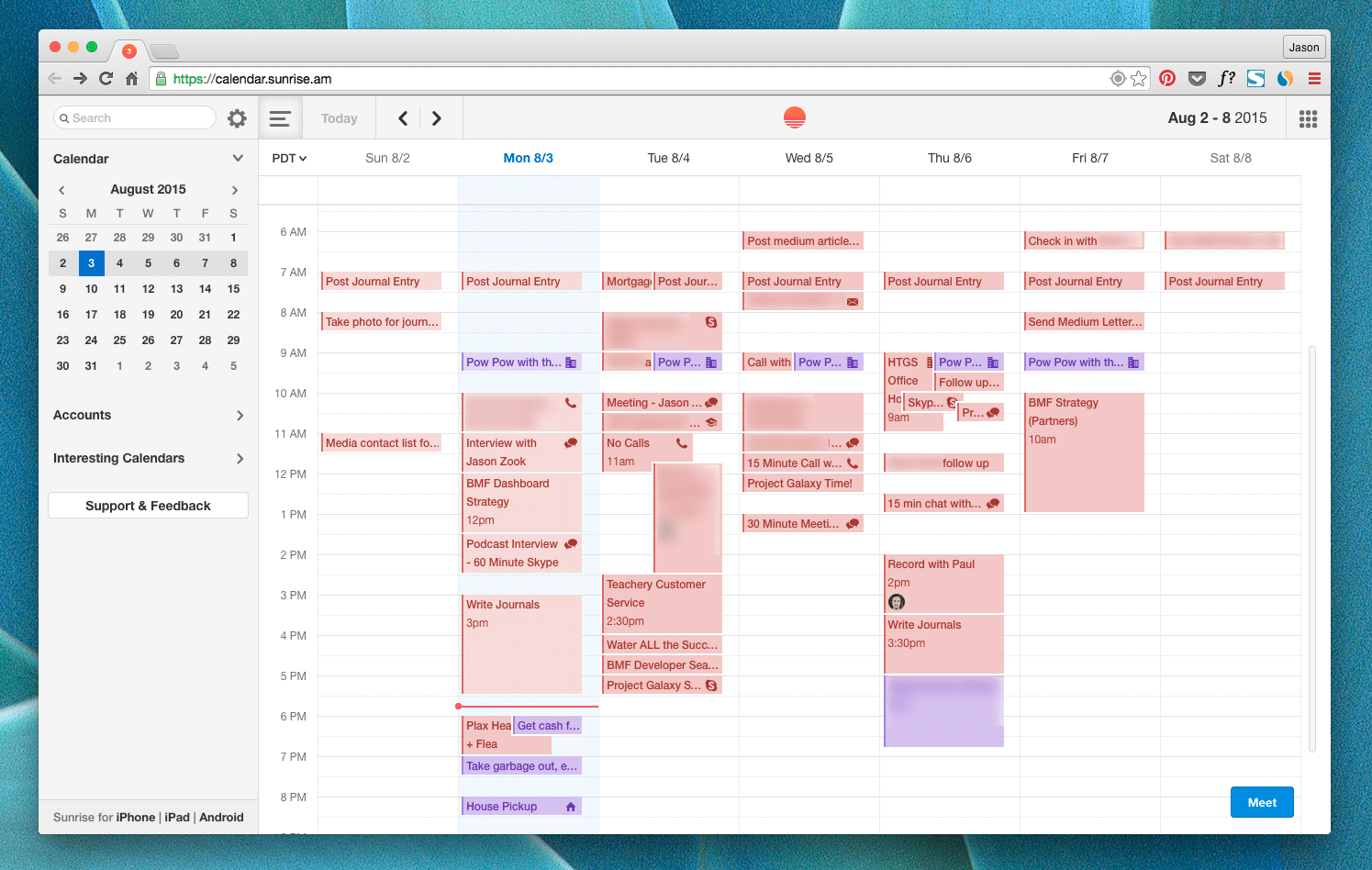
(A screenshot of my calendar during the BuyMyFuture planning and build.)
Why I only allow myself 30 minutes (or less) when going to the grocery store: No one needs to spend an hour browsing the aisles at the grocery store. Plus, this little trick keeps me from buying extra things I don’t need (because that would take too much time). I’m in and out, with only the items I needed, and I can get back to work or back to time off from work.
If you don’t feel you have the willpower to let your calendar dictate your life, try finding an accountability partner for a while. If you don’t have friends you want to trust with this task, hire a virtual assistant. For the $20-50 you’d spend a week having someone nag you, it might make you want to stick to your schedule more because you’re spending money on it.
Plus, it’s human nature not to let someone down. Whether that’s a friend or stranger somewhere else in the world, accountability can be very powerful.
We have too many tools at our disposal. A simple Google search for “writing app” brings up 252,000,000 results. Holy crap. How does anyone decide where to start? And the answer is not to click through until Page 5 or 6 in the Google search results, that’s just ludicrous.
The key is just to pick one tool and limit yourself to that one thing to start. Personally, I like to pick the tool with the least amount of features. As an example, I use the Bear App for writing. It doesn’t have a toolbar. It doesn’t have text decoration options. There isn’t even any text formatting. Not being able to waste time with features helps me get in the writing zone very quickly.
(The Bear writing app in action – This is where all my articles start!)
But how did I find Bear App? Through a friend on Twitter. A friend I trusted the opinion of and I knew was also an efficient writer. It’s one thing to take a recommendation from a friend who has successfully used that tool to their advantage. But if they’re just gushing about all the shiny and ‘interesting’ features it has, that might be a red flag that their recommendation isn’t the right thing for you.
Another way to test a tool is to set limitations with it. Let’s say it takes you one hour to do an existing task with an app you’ve been using for a while. If you want to try a new app, only allow yourself an hour to perform the same task. If you can’t get it done, then the new app isn’t worth the time investment. If you’re able to do the same task in half the time, then you definitely should switch apps.
It’s my honest opinion, coming from someone who’s created a dozen online courses, written two books, and built four software applications, that having constraints is a beautiful thing.
When I say constraints, I’m talking about a few specific things. The first is only doing the essential things needed to complete a project. The second is not letting assumptions dictate the amount of work you do.
Let me break both of these down for you…
Yet by constraining yourself to only work on a few things, you have a better chance of actually finishing your project and creating something with value. Here’s an example:
I have an online learning product called Teachery. For a year my co-founder Gerlando and I were heads-down building the best online course building tool we could, with the least amount of features possible.
Every time we’d think of a new feature idea, instead of spending time on it, we’d put it in a massive to-do list in Basecamp. Early on we set goals to help people quickly and easily build and sell beautiful online courses. If each feature we came up with didn’t directly relate to our goals, then it got put in the to-do list queue.
Recently we archived a queue of 50+ feature ideas. They weren’t bad ideas either. But by constraining ourselves to stick to the core features and work on perfecting them, we’ve been able to hit all our goals and milestones (which can be extremely tough when building a software product).
Now, when it comes to assumptions, I want to share an example of an online course I recently created. When I was writing the outline for the course I had 12 topic ideas. But when I sat down to create the course I told myself to pick the top 8 ideas I thought were most important to open up the course for purchase.
I assumed that people would be interested in the other 4 topics, but knew they weren’t absolutely necessary. I wrote a note in my outline next to those 4 topics that said: “If 5 people ask for any of these, I will create and add them as lessons in the course.” This small step would help test my assumption that people would want this information. So far no one has asked about any of them.
Now in both of these examples, you could argue that my projects could have been better with all the additional features and topics. And while I agree with you in principle, I also believe in the quote “Done is better than perfect”.
I’ve seen it with my own projects and with entrepreneurs and creative professionals time and time again. You want to over-deliver as much as possible to show the value of whatever you’re building. But it’s much easier to launch with less and add to a completed product, then it is to struggle to get a product to market that has a feature list a mile-long.
They help guide you and give you a compass to reach the finish line of whatever you’re working on. Lots of people get projects to 80-90% completion. Those same people struggle to get sales and always seem stressed out and overwhelmed. Get the best, smallest version of your project done and revel in your successes.
There’s a ton of power in completion.
“You can’t sustain this.”
“You need to take a break.”
“Eventually, you will burnout.”
Those were things that were told to me again and again in 2009 as I embarked on a business that operated 365 days out of the year. My inexperienced and naive self scoffed at the thought that my youthful invincibility would be tested.
Boy, was I wrong.
I felt stress and pressure, sure, but those didn’t inhibit my ability to do creative work. Yes, they added a tinge of difficulty, but they certainly weren’t insurmountable.
Out of nowhere, I felt like my creative spark was gone. I felt like I couldn’t come up with any new or interesting ideas. And I wanted absolutely nothing to do with my camera or my laptop thanks to filming more than 1,500 daily videos from 2009 to 2012. It’s now three years later, and I’m not exaggerating when I say that I’m only now feeling like I’ve overcome the disdain for my video camera.
I don’t bring up this topic so you’ll pity me. I also hope I don’t sound like a drama queen. I bring this topic up because I feel that many business owners, creative folks, and entrepreneurs are going to get blindsided by the evil bitch that is burnout, and I want to help you try to avoid that.
The other evening I had a discussion with friends who were both feeling burned out. I could see it on them, like a dingy, dirty, wet trench coat. They looked weighed down and tired.
I want to share a bit of context about these friends. They have two businesses they’re running. One business is established, is a well-oiled machine, and is profitable, but takes multiple hours every day to keep going. Their second business is a brand new business that they’ve been working on for months, but is just starting to see the light of day. The second business has a lot of technical details involved, customer support issues, and is all-around a bigger project.
As a group of us sat chatting in a circle on the floor of our living room, I could see it in their faces. A familiar look that I remember all too well. In most scenarios, I try to hold back a bit on being brutally honest (it gets me in trouble sometimes) but this time I recognized my former self in them and I wanted to get really honest about that.
What I shared with them (and what I’d like to impart upon you) is that burnout is not something you can simply work through.
There’s a difference between working long hours to get the job done and overworking yourself to the point of no return (that last one is burnout).
As soon as you see the signs of burnout, you have to attack it. And the best way to attack it? Take breaks. I know that sounds incredibly counterintuitive, but I honestly feel burnout is like an infection. The longer you ignore it and just let it fester, the worse it is going to get and the harder it is going to get rid of.
If you start to feel burnout creeping in, you have to take a step back. That doesn’t mean taking a week off to go to the Bahamas, but it does mean establishing time away from your work.
Your schedule could be a specific time, like the hours between 9 to 5 (especially if you work from home). Or it could only be a certain number of hours per day (and you stop, no matter what, when those hours are up). The important part is just that you create a schedule and then stick to it. I’d recommend starting with one schedule, trying it out for a week, and seeing how it feels.
It could also be very helpful for you to keep a journal of how you’re feeling. This might sound a bit “woo woo,” but if doing something that’s a bit “woo woo” helps you avoid an epic meltdown, then I think it’s worth doing. If you’re going to try a new schedule for a week, write in the journal every morning and evening. You don’t have to write a novel, just write a few sentences of how you’re feeling.
If you’re going to try journaling, I’d recommend doing it for a week with your current schedule and then another week with a schedule that allows you some breaks. After those two weeks, read through and see the differences between them. You may still have a feeling of overwhelming, but it might not be as daunting and you may not feel as stressed out.
In 2012, I pivoted my IWearYourShirt business to a new model and it was going well enough. I wasn’t swimming in money, Scrooge McDuck style, but things were looking a bit better. Looking back now, I can see that even the shift in my business didn’t help get rid of the burnout. Surprisingly, it actually seemed to continue to get worse.
We tend to think money is going to fix all our problems. But if you have problems before money comes along, and the problems don’t get solved, they’re only going to get worse with the stresses that get brought on by money (more customers to deal with, more employees, higher output of work, more pressure, etc).
Success is simply a byproduct of hard work. Success doesn’t fix problems. It doesn’t heal wounds. It’s merely an outcome.
The first part of asking for help is difficult. Trust me, I once waited eight entire months to send someone an email who I completely believed could help me out. Pride is a dangerous beast. But it’s the second part that comes along with asking for help that can really cause complications: actually taking the advice you get and doing something with it.
You aren’t doing yourself any favors if you muster up the courage to ask for help and then remain set in your old ways. Whatever you were doing up until the point of asking for help was leading to burnout, so it’s time to make a change. You certainly don’t have to take someone’s full advice, but maybe there’s one small thing you can start doing right away. That one thing might lead to another, which leads to another, etc.
For folks who own their own businesses, burnout is very likely to rear its ugly head at some point or another. You might not be dealing with burnout right now, and in that case, it’s my hope that this article gives you some semblance of preparation when you start to see some signs of it.
I don’t think we as entrepreneurs talk enough about the dangers of overworking ourselves or the negative feelings that can come with running our businesses, feelings like burnout. I hope this article reminds you that your business is not the only thing in your world. If you don’t take time and attention to care for yourself as you continue to follow your dreams, all the success you’re working so hard to achieve won’t be worth what you had to sacrifice to get it.
Take care of yourself and your business will follow.
During my latest trip out to California, I found myself in a conversation with some friends about momentum.
When it comes to building a creative business, I don’t know if this is the case for everyone, but for me at least, there seems to be a kind of rhythm to things. You can almost feel when things are slowing down or speeding up. Lately I’ve sensed them speeding up, and the momentum has left me feeling more inspired and driven than ever.
Imagine this: you’re tasked with the seemingly impossible feat of moving a huge wrecking ball. (Don’t worry, in this visual, Miley is NOT on top of the wrecking ball.)
If you were going to try and move this wrecking ball, would you run full speed at it and hope that your one-hit force sends it soaring? Heck no! That thing would lay you out!
Instead, you might just give it a tiny nudge at first to get the thing moving. That first nudge would create a bit of momentum which then would work in your favor the next time you nudge it. And the next. And the next. Each nudge would then gets easier and easier with greater impact. Before you’d know it, you’d have a huge wrecking ball swinging through the air. (ps. Is anyone else picturing George Banks diving in front of this wrecking ball from Father of the Bride II?) (pps. Dear physics junkies out there, please don’t crush my spirits by sending me emails with why a single human moving a wrecking ball defies the laws of the universe or whatever. It’s a metaphor. Cool? Cool.)
The point of this visual is, whether it’s starting a thriving business or changing a certain aspect of your life, at times, undertakings that large can feel like a two-ton wrecking ball. Like there’s no way you can get it moving on your own. BUT YOU CAN. All you need is to create a little momentum. And how do you build momentum? With small wins. With tiny nudges.
Have you ever watched a football game where one team is down and out and somehow they manage to come from behind and win it all? Well, how do they do it? How do they shift the momentum of the game in their favor?
Usually, it starts with just one play. One interception that shifts the team’s confidence or one big completion that gives them the hope they need. From that point on, it doesn’t feel like such an uphill battle. That momentum-shifting play is what you’re looking for when you need a small win.
There’s a lot of advice out there that says “Start before you’re ready,” or “Just start,” or “Take action,” and I think that advice is great. BUT I also know that there are some of you out there thinking, but HOW do I start? How do you find the courage to move forward when every fiber of your being is acutely aware of the gargantuan task that lays before you?
By identifying small wins, you can start to shift the momentum in your favor and no longer will it feel like you have to move a wrecking ball. Just like I mentioned, with each consecutive nudge, it will feel easier and easier to move forward.
If you want to make your blog more active, a small win for you could mean writing a post every day for one week. If you want to start an Etsy shop, a small win could be simply setting up the store and posting just ONE listing. If you want to finally start eating healthy, start by promising yourself to eat out just one night a week.
Whatever those small wins are for you, I’m telling you that if you get enough of them under your belt, starting a business won’t feel so big and scary. Developing better habits won’t seem impossible. Changing your life will appear well within your reach.
So, remember:
“Small wins create the momentum you need to start taking on your biggest goals.”
Make it substantial enough that it can create some momentum for you, but bite-sized enough that you’ll hit it out of the park.
Let’s make this the week where the momentum changes in your favor.
I didn’t take wood shop in high school. I thought it sounded dumb and I was more of a creative kid and tech geek growing up. But I found myself very interested in reclaimed wood projects I’d find on Instagram, Pinterest, or in catalogues from companies like West Elm or CB2. As I’ve aged (like a fine wine) I’ve gotten better at working with my hands. But with age, and time building online businesses, I’ve also become more distracted than ever.
My wife Caroline had been living with me for a few years, and since day one she’d turned our house from “undecorated bachelor pad” to “modern and stylish living space.” Whenever we changed something in the house, I always gravitated towards wood tones and textures. The obsession began…
If you’ve never seen one, a reclaimed wood wall is fairly simple; you take planks of wood and just like you’d install a wood floor, you install them on the wall (with a nail gun, glue, double-sided tape, or a mixture of the three). After weeks of imagining wood on ALL the walls of our house (I even did some terrible photoshop mockups), it was time to bite the wooden bullet.
I knew there were used wood pallets behind a hardware store near our house. I went to the store and asked someone working there if people (me) could take the used pallets that were piled up in the back. He said that they had a specific pile that was broken or not useable and I was free to take as many of those as I wanted. I went to the back of the store and piled my first few pallets into the bed of my red 1948 Chevy pick-up truck (aptly named CLIFFRD, after the Big Red Dog cartoon character, obviously).

(Yay for taking photos for memories!)
I had no idea how many pallets I’d need, so I just piled in as many as I could fit in the truck. When I got home I started the hardest part of any reclaimed wood project; getting the wood from whatever state it was in (in this case nailed-together pallets) into useable planks.
Not only did I break a hammer in half, I also found wearing flip-flops (hey I lived in Florida) and not wearing thick gloves would prove to be bad ideas. Luckily there was no blood, but let’s just say I nearly whacked my shin a couple times, and definitely had pieces of wood flying everywhere around my feet. A few hours later, with some quick learning from initial mistakes, I figured out a process that worked well to remove the salvageable planks of wood. For those of you keeping track, I had also put on shoes.
I had an idea of what I thought would work in taking the pallets apart. It didn’t work. I tried something else. That worked better. I kept iterating and learning from what I was doing, just like you would in business.
Once I had a sizable pile of useable planks of reclaimed wood I took some measurements of the wall in my office I was going to turn from drab-to-fab (yeah, I just said that). Once I had the measurements of the wall, I went back to my garage and started laying out the planks on the floor, just as they would go on the wall. As I started to lay the wall out I could feel myself getting more and more excited to complete the project (and the nail gun I’d rented).

(please note the shoes – no more flip flops!)
I made tons of measurements, trimmed multiple planks of wood, ruined multiple planks of great wood (ughh), and had finally completed the wall layout. If you’ve ever built an online course, an app, or even just put together a website, it’s very similar (minus the splinters).
The next step in creating my awesome reclaimed wood wall was to transition the layout, plank by plank, to my upstairs office. I chose to do it piece by piece because even though I measured the wall, you just never know what’s going to happen especially with so many variables involved (slanted walls, tons of different thickness of planks of wood, bad installation by me, etc). Plus, my wife wouldn’t have been happy with me sawing pieces of wood in our carpeted office.
As I installed each plank, I found myself doing a ton of re-measuring and trimming. Again, more iteration. More tweaking. More learning as I went. I could have easily just put every wood plank on the wall as I had originally laid it out, but the wall would have turned out terribly.
Plank by plank, I made sure the wall came together and looked right. With each piece of wood installed, I felt more accomplished and more motivated to finish the project.
I remember my increasing enjoyment of the process of carrying each plank from the garage to my office and installing it the closer I got to completion. I also nailed my steps and stairs-climbed goals on my Fitbit that day.
Eventually each plank was installed and I had a completed reclaimed wood wall. It felt awesome to complete the task and the wall looked really cool!
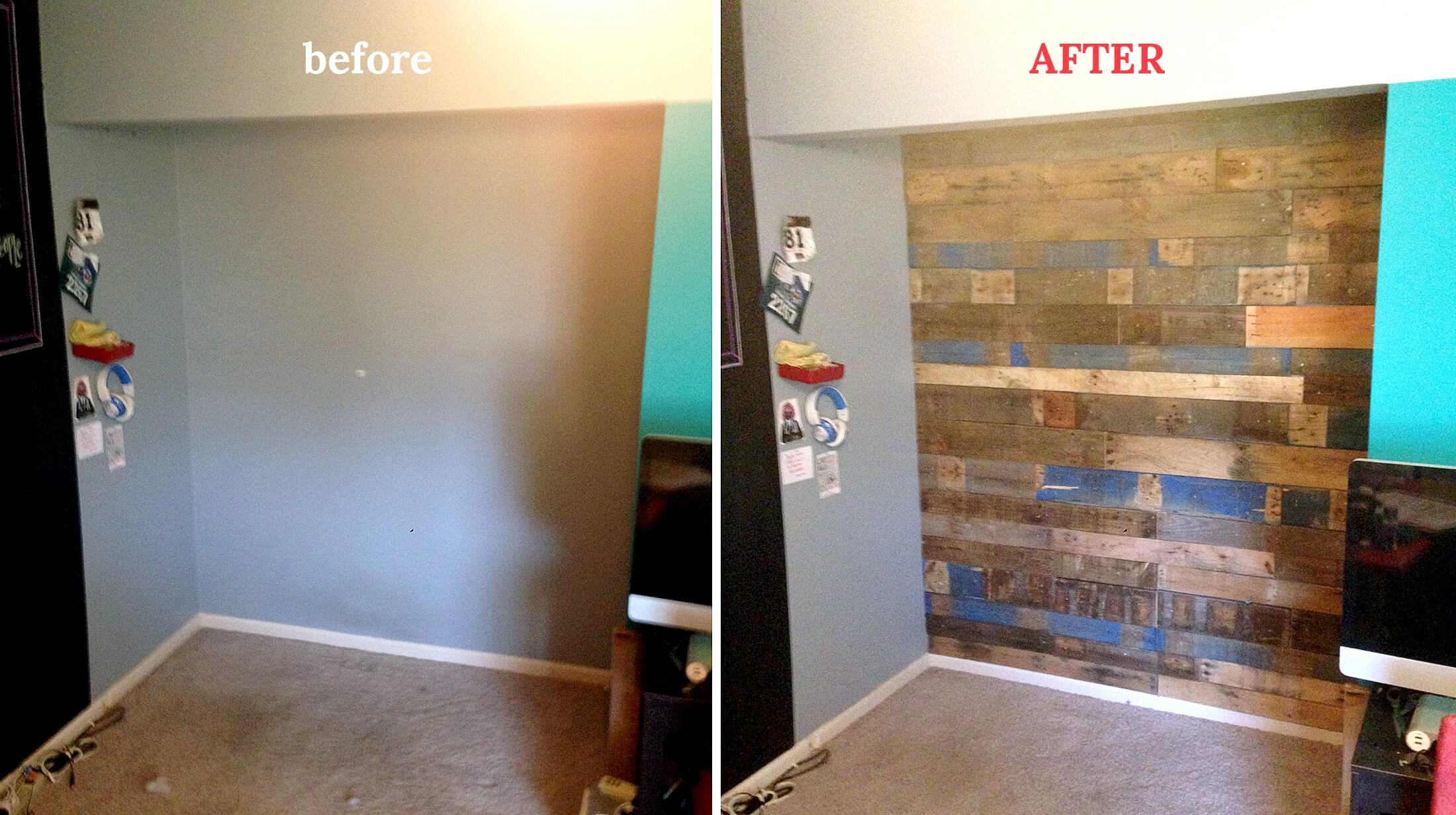
(sorry for the crappy quality photo, twas the iPhone 4 days!)
My wife also got a bit tired of the random color scheme we had in our office (notice the black wall, green wall, and gray wall in the photo above). We spent one weekend repainting our entire office white with one bright yellow accent wall. I give my wife all the credit in the world for her design-eye. I can only take credit for the stuff that needed hammering, cutting, and installing – hah.
Related note: A fresh coat of paint on your website goes a long way too. Read about the redesign of JasonDoesStuff.
The photos below show you a few other projects I got inspired to do. Part of that inspiration came from the giant pile of wood planks that were taking up room in our garage.
Funny enough, during this reclaimed wood phase, I wrote my first book in two weeks. I had so much motivation and inspiration from completing all my offline projects and I was able to channel that into an online project. You can grab a copy of my first book, Creativity For Sale, on Amazon if you like.
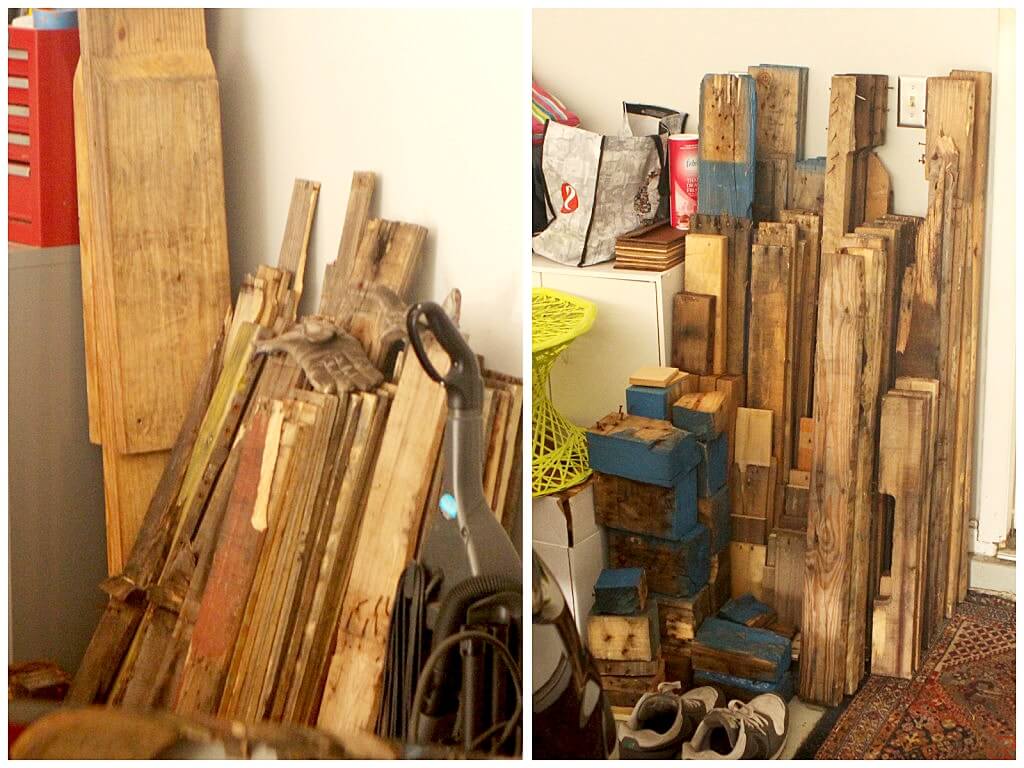
(I don’t know how I lived with this clutter in our garage, haha)

(A super simple outdoor table I whipped together from scraps)
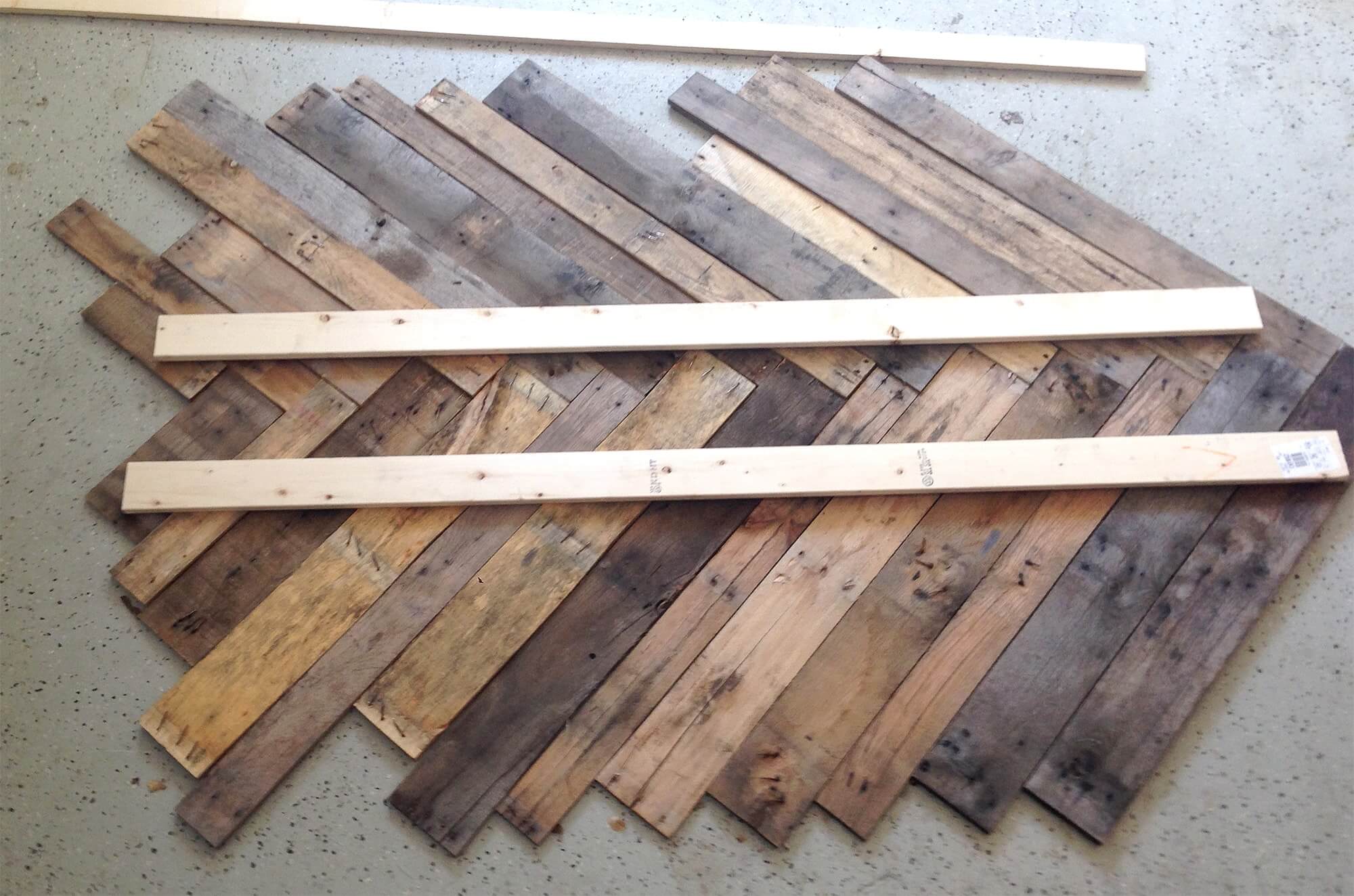
(The start of an art piece I built for our living room)
(The finished pallet wood art piece! I also built the coffee table from a plank of cedar and piping from Home Depot. On the outdoor patio you can see the outdoor table. Decoration choices by my wife – obviously.)
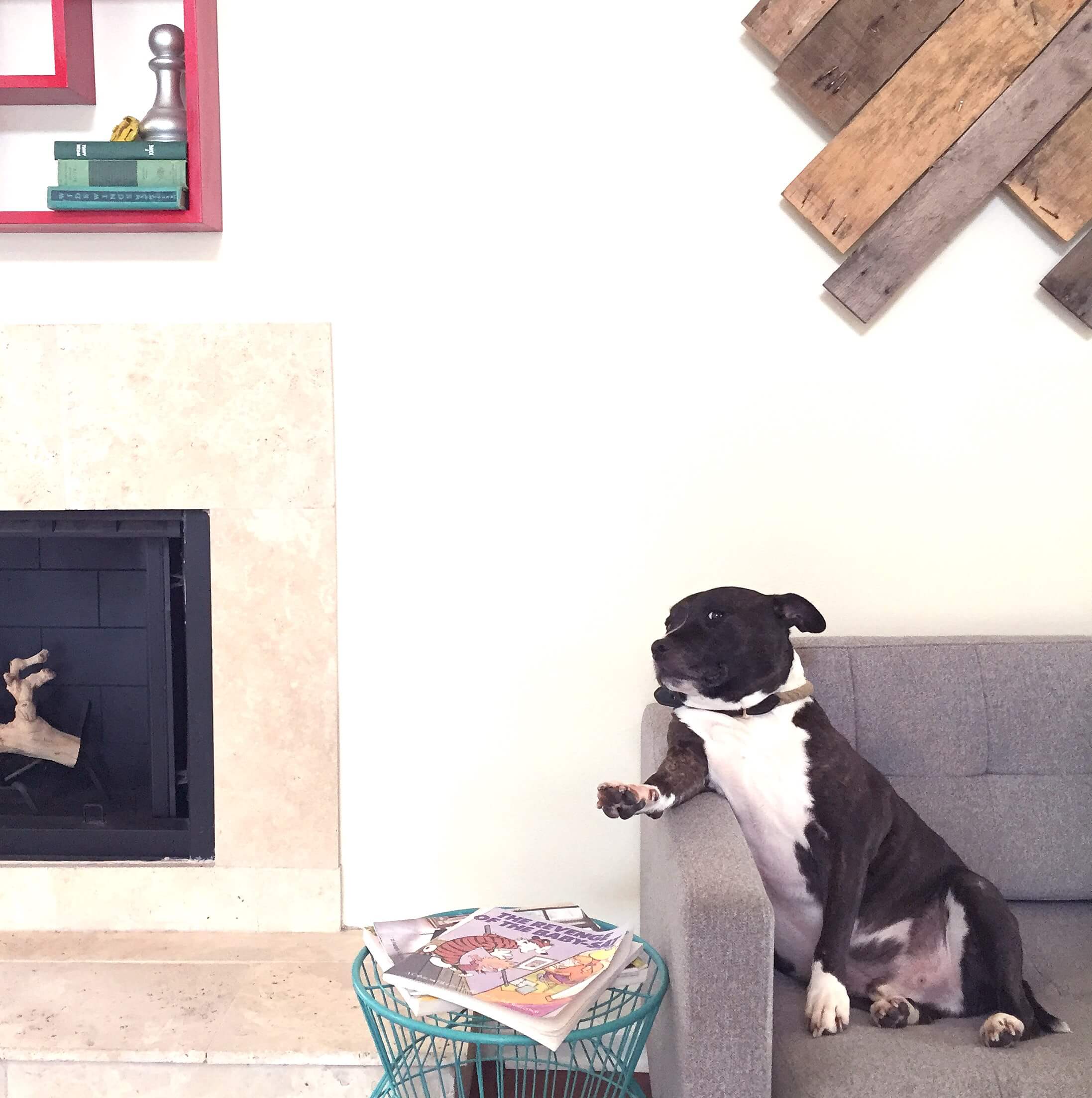
(Our dog Plaxico, doing what he does.)

(There were no shortage of trips to fill CLIFFRD with pallets!)
The more I do projects with my hands, disconnecting from the online word, the more I feel inspired to create in all areas.
Often, the time we spend online doesn’t feel like things are getting completed. You write tweets, you read tweets, that’s it. You scroll through your Facebook News Feed, you like photos of babies, you share a witty status or funny photo, and you move on. You read emails, you send emails, you get more emails. It’s a never-ending cycle without completion.
It’s a really empowering feeling to complete projects. It’s helped me transition the same thought process into work I’m doing online. If I’m writing a blog post or article, I try to stay in the moment as long as possible and finish the post.
There are so many distractions online. We constantly feel like we’re being pulled in a million directions. Yet, when you’re building something with your hands, you’re in the moment of each specific task (mostly because you could lose a finger, whack yourself with a hammer, or get splinters in your toes – wear shoes!).
Building things with reclaimed wood was a nice escape from refreshing every feed or inbox on my iPhone/laptop. It also helped me get better at focusing on singular tasks.
The power of completion has been hugely helpful for me and I encourage you to try it. Get out there and build something with your hands!
